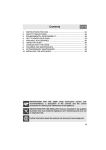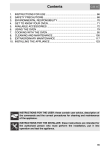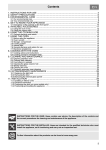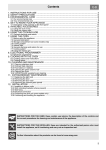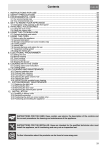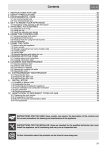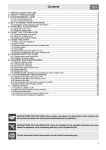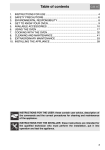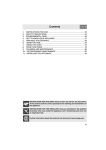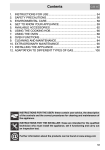Download Instruction manual
Transcript
Contents 1. INSTRUCTIONS FOR USE ................................................................................................................................... 4 2. SAFETY PRECAUTIONS ...................................................................................................................................... 6 3. ENVIRONMENTAL CARE ..................................................................................................................................... 8 3.1 Our environmental care .................................................................................................................................. 8 3.2 Your environmental care ................................................................................................................................. 8 4. GET TO KNOW YOUR APPLIANCE ..................................................................................................................... 9 4.1 Description of the controls on the front panel ............................................................................................... 10 5. AVAILABLE ACCESSORIES ............................................................................................................................... 11 5.1 Using the rack or tray .................................................................................................................................... 11 5.2 Using the support rack .................................................................................................................................. 12 5.3 Using the reduction pan stands .................................................................................................................... 12 6. USING THE COOKING HOB ............................................................................................................................... 13 6.1 General warnings and advice ....................................................................................................................... 13 6.2 Lighting the hob burners ............................................................................................................................... 13 6.3 Practical hints for using the hob burners ....................................................................................................... 13 6.4 Cookware diameters ..................................................................................................................................... 14 7. USING THE OVEN .............................................................................................................................................. 15 7.1 Before using the appliance ........................................................................................................................... 15 7.2 Oven runners ................................................................................................................................................ 15 7.3 Storage compartment (on some models only) .............................................................................................. 15 7.4 Cooling system ............................................................................................................................................. 15 7.5 Internal light .................................................................................................................................................. 15 7.6 General warnings and advice for use ........................................................................................................... 16 7.7 Using the bottom burner ............................................................................................................................... 17 7.8 Using the electric grill .................................................................................................................................... 17 8. COOKING WITH THE OVEN ............................................................................................................................... 18 8.1 Cooking advice and instructions ................................................................................................................... 19 8.2 Cooking information table ............................................................................................................................. 20 9. CLEANING AND MAINTENANCE ....................................................................................................................... 21 9.1 Cleaning stainless steel ................................................................................................................................ 21 9.2 Ordinary daily cleaning ................................................................................................................................. 21 9.3 Food stains or residues ................................................................................................................................. 21 9.4 Cleaning the cooking hob parts .................................................................................................................... 21 9.5 Cleaning the oven ......................................................................................................................................... 22 10. EXTRAORDINARY MAINTENANCE ................................................................................................................ 24 10.1 Replacing the light bulb ............................................................................................................................... 24 10.2 Removing the door ...................................................................................................................................... 24 10.3 Removing the door seal (not on pyrolitic models) ....................................................................................... 25 10.4 Removing the internal glass panels ............................................................................................................ 25 11. INSTALLATION ................................................................................................................................................. 26 11.1 Clearances above and around domestic appliances .................................................................................. 26 11.2 Combustion gas discharge ......................................................................................................................... 26 11.3 Gas connection ........................................................................................................................................... 27 11.4 Room ventilation ......................................................................................................................................... 27 11.5 Extraction of the combustion products ........................................................................................................ 27 11.6 Electrical connection ................................................................................................................................... 28 11.7 Positioning the skirt (on some models only) ................................................................................................ 29 11.8 Positioning and levelling the appliance ....................................................................................................... 29 11.9 Wall mounting brackets (where present) ..................................................................................................... 29 11.10 Wall fixing .................................................................................................................................................. 30 12. ADAPTATION TO DIFFERENT TYPES OF GAS ............................................................................................. 31 12.1 Replacing the hob nozzles .......................................................................................................................... 31 12.2 Replacing the bottom burner's nozzle ......................................................................................................... 31 12.3 Arrangement of burners .............................................................................................................................. 32 12.4 Final operations .......................................................................................................................................... 32 12.5 Burner and nozzle characteristics table ...................................................................................................... 33 INSTRUCTIONS FOR THE USER: these contain user advice, the description of the controls and the correct procedures for cleaning and maintenance of the appliance. INSTRUCTIONS FOR THE INSTALLER: these are intended for the qualified technician who must install the appliance, set it functioning and carry out an inspection test. @ Further information about the products can be found at www.smeg.com 3 General instructions 1. INSTRUCTIONS FOR USE This manual is an integral part of the appliance. It must be kept in its entirety and in an accessible place for the whole working life of the appliance. We recommend reading this manual and all information it contains carefully before using the appliance. Installation must be carried out by qualified personnel in accordance with the standards in force. This appliance is intended for domestic use and conforms to the EC directives currently in force. The appliance has been built to carry out the following functions: cooking and heating up food; all other uses are considered unsuitable. These instructions are valid only for the destination countries whose identifying symbols are included on the cover of this manual. Never obstruct the openings and slots provided for ventilation and heat dispersal; this may cause malfunctions. Do not use this appliance for heating rooms. The identification plate with technical data, serial number and brand name is located in an exposed position either in the drawer (where present) or on the back of the appliance. A copy of the identification plate is included in the booklet. It should be applied to the appropriate space on the back of the cover. Do not remove this plate for any reason. Before the appliance is put into operation, all labels and protective films applied on external surfaces must be removed. Do not use metallic sponges or sharp scrapers: they will damage the surfaces. Use normal non-abrasive products and a wooden or plastic tool if necessary. Rinse thoroughly and dry using a soft cloth. Do not allow residues of sugary foods (such as jam) to set inside the oven. If left to set for too long, they might damage the enamel lining of the oven. Do not use plastic kitchenware or containers. The high temperatures inside the oven could melt the plastic, damaging the appliance. Always check that the control knobs are in the “zero” (off) position when you finish using the appliance. Do not use sealed tins or containers in the appliance. Overpressure may occur inside the containers during cooking, creating a danger of explosion. Do not cover the bottom of the oven with aluminium or tin foil sheets during cooking and do not place pans or trays on it to avoid damage to the enamelled surface. Never place saucepans with bases which are not perfectly flat and smooth on the hob. Unstable cookware can lead to scalding. Do not rest any weight or sit on the open door of the appliance. Excessive weight may jeopardise its stability. The appliance becomes very hot during use. Suitable heat-proof gloves should be worn for all operations. 4 General instructions Do not use the hob if pyrolysis (where present) is taking place inside the oven. If you intend to go away for a prolonged period of time, close the mains gas tap or the gas cylinder tap. Take care that no objects are stuck in the door of the oven. Do not open the storage compartment (where present) when the oven is on and still hot. The temperatures inside it may be very high. If the surfaces are still very hot during cooking, do not pour water directly onto the trays. The steam could cause severe burns and damage enamelled surfaces. All cooking operations must take place with the door closed. The dissipation of heat may cause hazards. The manufacturer declines all responsibility for damage to persons or things caused by nonobservance of the above prescriptions or by interference with any part of the appliance or by the use of non-original spare parts. 5 General instructions 2. SAFETY PRECAUTIONS Consult the installation instructions for safety standards on electrical or gas appliances and for ventilation functions. In your interests and for your safety the law requires that the installation and servicing of all electrical and gas appliances be carried out by qualified personnel in accordance with the standards in force. Our approved installers guarantee a satisfactory job. Gas or electrical appliances must always be uninstalled by suitably skilled people. Before connecting the appliance to the power grid, check the data on the plate against the data for the grid itself. If the appliance is installed on a raised platform, secure it using suitable fastening systems. Before carrying out installation/maintenance work, make sure that the appliance is disconnected from the power grid. If cooking appliances are installed in motor vehicles (for example, camper vans, caravans etc.), they must only be used when the vehicle is stationary. Install the appliance so that when opening the drawers or doors of units positioned at the level of the hob there is no possibility of making contact with pans positioned on top of it. Immediately after installation, carry out a quick test on the appliance following the instructions provided later in this manual. Should the appliance not function, disconnect it from the power supply and call the nearest technical assistance centre. The plug to be connected to the power supply cable and its socket must be of the same type and conform to the standards in force. The socket must be accessible after the appliance has been installed. Never disconnect the plug by pulling on the cable. If the power supply cable is damaged, contact the technical assistance centre immediately and they will replace it. The appliance must be connected to earth in compliance with electrical system safety standards. During use the appliance and its accessible parts become very hot. Take care never to touch the heating elements. Keep children younger than 8 away from the appliance, unless under continuous supervision. Never put inflammable objects in the oven: they could be accidentally ignited and cause fires. The appliance is intended for use by adults. Do not allow children to go near it or play with it. This appliance may be used by children from the age of 8 and by people of reduced physical and mental ability or lacking in experience and knowledge, provided they are supervised or instructed on the safe use of the appliance and if they understand the associated risks. Do not allow children to play with the appliance. Do not allow unsupervised children to perform cleaning or maintenance operations. Never attempt to repair the appliance. All repairs must be carried out by an authorised technician or at an authorised service centre. The improper use of tools can cause hazards. This appliance must not be controlled using an external timer or remote control system. 6 General instructions Be aware of how rapidly the cooking zones heat up. Do not place empty saucepans on the heat. Danger of overheating. Fats and oils can catch fire if they overheat. You are therefore recommended not to leave the appliance unattended while preparing foods containing oils or fats. If fats or oils catch fire, never put water on them. Place the lid on the saucepan and turn off the cooking zone. Take care when using additional electrical appliances in the kitchen (e.g. blender, toaster etc.). Connection cables must not come into contact with hot cooking zones. Do not use steam jets for cleaning the appliance. The steam could reach the electronics, damaging them and causing short-circuits. Do not spray any spray products near the household appliance while it is in operation. Do not use spray products while the appliance is still hot. The gases contained in spray cans may catch fire. The manufacturer declines all responsibility for damage to persons or things caused by nonobservance of the above prescriptions or by interference with any part of the appliance or by the use of non-original spare parts. 7 Instructions for disposal 3. ENVIRONMENTAL CARE 3.1 Our environmental care Adequate selective collection for the subsequent forwarding of the decommissioned product to recycling, treatment and ecologically compatible disposal contributes to avoiding possible negative effects on the environment and on health and promotes the recycling of the materials of which the appliance consists. Illicit disposal of the product by the user will lead to the application of administrative sanctions. The appliance does not contain substances in quantities sufficient to be considered hazardous to health and the environment, in accordance with current European directives. 3.2 Your environmental care Our appliances are packed in non-polluting materials, which are therefore compatible with the environment and recyclable. Please help by disposing of the packaging correctly. You can obtain the addresses of collection, recycling and disposal centres from your retailer or from the competent local organisations. Do not discard the packaging or any part of it, or leave it unattended. It can constitute a suffocation hazard for children, especially the plastic bags. Your old appliance also needs to be disposed of correctly. Important: hand over your appliance to the local agency authorised for the collection of electrical appliances no longer in use. Correct disposal enables intelligent recovery of valuable materials. Before disposing of your appliance it is important to remove doors and leave shelves in the same position as for use, to ensure that children cannot accidentally become trapped inside during play. It is also necessary to cut the connecting cable to the power supply network, removing it along with the plug. 8 Instructions for the user 4. GET TO KNOW YOUR APPLIANCE Cooking hob Control panel Oven seal Oven light (double on some models) Door sensor (on some models only) Rack/tray support frame Fan Roof liner (on some models only) Door Bottom gas burner 9 Instructions for the user 4.1 Description of the controls on the front panel 4.1.1 Timer knob This knob allows to set the timer. The numbers indicated are minutes. Adjustment is progressive so that the time can also be set to any intermediate value between these numbers. At the end of the set time, a buzzer will sound but cooking will not be interrupted. The timer does not stop the cooking operation. It only warns the user that the preset number of minutes has passed. 4.1.2 Function selection knob This knob allows to select different oven functions. For further information see “8. COOKING WITH THE OVEN”. When using the grill or the fan-assisted grill, the light comes on to signal that the oven is heating up. When this light goes out, the preset heating temperature has been reached. 4.1.3 Gas oven thermostat knob This knob allows to light the bottom burner inside the oven. The cooking temperature is selected by turning the knob anti-clockwise to the required setting, between MIN and MAX. For further information see “7.7 Using the bottom burner”. To switch on the light while the bottom burner is being used, turn the timer knob to symbol 4.1.4 Hob burners control knob To light the flame, press the knob and turn it anti-clockwise to the maximum flame symbol ( ). To adjust the flame, turn the knob to the zone between the maximum ( ) and the minimum ( ) settings. To turn off the burner, turn the knob to the position. (The adjacent symbol indicates the front left burner). 10 . Instructions for the user 5. AVAILABLE ACCESSORIES NOTE: Some models are not provided with all accessories. Rack: useful for holding cooking containers. Tray rack: to be placed over the top of the oven tray; for cooking foods which may drip. Oven tray: useful for collecting fat from foods placed on the rack above. Deep oven tray: useful for baking cakes, pizza and oven-baked desserts. Reduction pan stand: useful when using small pans. WOK reduction: useful when using a wok. The oven accessories intended to come into contact with food are made of materials that comply with the provisions of current legislation. Accessories available on request: • Original supplied and optional accessories may be ordered from any Authorised Assistance Centre. • Use only original accessories supplied by the manufacturer. 5.1 Using the rack or tray The racks or trays are equipped with a mechanical safety lock which prevents them from being taken out accidentally. To insert the rack or tray correctly, check that the lock is facing downwards (as shown in the figure at the side). To remove the rack or tray, lift the front slightly. The mechanical lock (or the extension piece where present) must always face the back of the oven. Gently insert racks and trays into the oven until they come to a stop. In models with guides, clean the trays before using them for the first time. Cleaning will remove any manufacturing residues, which may otherwise scratch the sides of the oven cavity when trays are being inserted. 11 Instructions for the user 5.2 Using the support rack The support rack is inserted into the tray (as shown in the figure). Using this, foods can be cooked and the fat can be collected separately from the food which is being cooked. 5.3 Using the reduction pan stands The reduction pan stands should be placed on top of the hob pan stands as shown in the adjacent figure. Make sure they are stable. The WOK pan stand should only be used when cooking with a wok. 12 Instructions for the user 6. USING THE COOKING HOB 6.1 General warnings and advice Before lighting the hob burners, make sure that the flame-spreader crowns are correctly positioned in their housings with their respective burner caps. 6.2 Lighting the hob burners All the appliance's control and monitoring devices are located together on the front panel. The burner controlled by each knob is shown next to the knob. The appliance is equipped with an electronic lighter. Simply press the knob and turn it anti-clockwise to the maximum flame symbol until the burner lights. If the burner does not light in the first 15 seconds, turn the knob to “0” and wait 60 seconds before trying again. After lighting, keep the knob pressed down for a few seconds to allow the thermocouple to heat up. The burner may go out when the knob is released: in this case, the thermocouple has not heated up sufficiently. Wait a few moments and repeat the operation, keeping the knob pressed for longer. If the burners should go out accidentally, a safety device will be tripped, cutting off the gas supply, even if the gas tap is open. In this case, turn the knob to the OFF position and wait at least 60 seconds before trying to light the burner again. 6.3 Practical hints for using the hob burners For better burner efficiency and to minimise gas consumption: use pans with lids and of a suitable size for the burner, so that the flames do not reach up the sides of the pan (see paragraph “6.4 Cookware diameters”). Once the contents come to the boil, turn down the flame far enough to ensure that the liquid does not boil over. If any liquid does boil over or spill, remove the excess from the hob. To prevent burns or damage to the hob during cooking, all pans or griddles must be placed inside the perimeter of the hob. All pans must have smooth, flat bottoms. If the flame accidentally goes out, turn off the control knob and wait at least 1 minute before trying to re-light the burner. Take the greatest care when using fats or oils since they may catch fire if overheated. 13 Instructions for the user 6.4 Cookware diameters Burner Ø min. (cm) Ø max. (cm) Auxiliary 12 14 Semi-rapid 16 24 Ultra-rapid 18 26 To prevent damage to the appliance or adjacent units, all pans or griddles must be placed inside the perimeter of the hob. 14 Instructions for the user 7. USING THE OVEN 7.1 Before using the appliance • Remove any labels (apart from the technical data plate) from trays, dripping pans and the cooking compartment. • Remove any protective film from the outside or inside of the appliance, including from accessories such as trays, dripping pans, the pizza plate or the base cover. • Before using the appliance for the first time, remove all accessories from the oven compartment and wash them as indicated in “9. CLEANING AND MAINTENANCE”. Heat the empty appliance to the maximum temperature in order to remove any manufacturing residues which could affect the food with unpleasant odours. 7.2 Oven runners The oven features 5 runners for positioning trays and racks at different heights. The insertion heights are indicated from the bottom upwards (see figure). models with frames models with guides 7.3 Storage compartment (on some models only) The storage compartment is in the bottom of the cooker. It provides storage space for the appliance’s metal accessories and must not be used to store flammable materials, cloths, paper etc. Do not open the storage compartment when the oven is on and still hot. The temperatures inside it may be very high. 7.4 Cooling system The appliance is equipped with a cooling system which comes into operation as soon as a cooking function starts, with the exception of the gas burner where start-up is delayed. The fan causes a steady outflow of air that exits from the rear of the appliance and which may continue for a brief period of time even after the appliance has been turned off. 7.5 Internal light The light inside the oven comes on when any function is selected, except when the bottom burner is being used, in which case the timer knob must be turned to symbol . 15 Instructions for the user 7.6 General warnings and advice for use All cooking operations must be carried out with the door closed. The dissipation of heat may cause hazards. During cooking, do not cover the bottom of the oven with aluminium or tin foil and do not place pans or oven trays on it as this may damage the enamel coating. If you wish to use greaseproof paper, place it so that it will not interfere with the hot air circulation inside the oven. For the best cooking results, we recommend placing cookware in the centre of the rack. To prevent any steam in the oven from causing problems, open the door in two stages: keep it half open (5 cm approx.) for 4-5 seconds and then fully open. To access food, always leave the door open as short a time as possible to prevent the temperature in the oven from falling and ruining the food. To prevent excessive amounts of condensation from forming on the internal glass, hot food should not be left inside the oven for too long after cooking. While cooking desserts or vegetables, excessive condensation may form on the glass. In order to avoid this, open the door very carefully a couple of times while cooking. To prevent hazardous overheating, the appliance's lid (where present) must always be raised when using the oven. Heat the empty appliance to the maximum temperature in order to remove any manufacturing residues which could affect the food with unpleasant odours. 16 Instructions for the user 7.7 Using the bottom burner 7.7.1 Electronic spark ignition Open the oven door fully, press the thermostat knob and turn it anti-clockwise between MIN and MAX; the electric spark ignition is activated automatically. After lighting, keep the knob pressed down for a few seconds to allow the thermocouple to heat up. If the burner does not ignite after 15 seconds, stop attempting to light it, leave the oven door open and do not try to light it again for at least 1 minute. The bottom burner cannot be lit with the oven door closed. 7.7.2 Manual ignition In the event of a power failure, the oven can be ignited manually. Open the oven door fully, press and turn the thermostat knob anti-clockwise between MIN and MAX; light a long match and put the flame through the centre front slots at the bottom of the oven (as indicated in the figure). Alternatively you can use an electric gas lighter with a long spout. After lighting, keep the knob pressed down for a few seconds to allow the thermocouple to heat up. If the burner does not ignite after 15 seconds, stop attempting to light it, leave the oven door open and do not try to light it again for at least 1 minute. If the burner is extinguished accidentally, turn the knob to the off position (0) and wait at least one minute before trying to light it again. 7.8 Using the electric grill Use the function selection knob to select either the grill or the fan-assisted grill. For further information see “8. COOKING WITH THE OVEN”. Lighting the gas burner will switch off the electric grill element. The bottom burner and the electric grill can never be used at the same time. • • Grilling processes must never last more than 60 minutes. Accessible parts may be very hot during and after use of the grill; keep children well away from the appliance. 17 Instructions for the user 8. COOKING WITH THE OVEN GRILL: The heat coming from the grill element gives perfect grilling results above all for thin and medium thickness meat and in combination with the rotisserie (where present) gives the food an even browning at the end of cooking. Perfect for sausages, ribs and bacon. This function enables large quantities of food, particularly meat, to be grilled evenly. (4th or 5th runner). FAN-ASSISTED GRILL: The air produced by the fan softens the strong heatwave generated by the grill, grilling perfectly even very thick foods. Perfect for large cuts of meat (e.g. shin of pork). We recommend using the 4th runner. FAN: This function is useful for activating ventilation while using the bottom gas burner. The air produced by the fan helps distribute heat evenly inside the oven. DEFROSTING: Rapid defrosting is helped by switching on the fan to ensure uniform distribution of air inside the oven. (We recommend using the 1st or 2nd runner). 18 Instructions for the user 8.1 Cooking advice and instructions 8.1.1 General advice • We recommend preheating the oven before putting food in. Place the food in the oven only once the cooking light is off. • • For cooking on several levels, we recommend using a fan-assisted function to achieve uniform cooking at all heights. • In general, it is not possible to shorten cooking times by increasing the temperature (the food could be well-cooked on the outside and undercooked on the inside). • While cooking desserts or vegetables, excessive condensation may form on the glass. In order to avoid this, open the door very carefully a couple of times while cooking. • For rapid preheating use a fan-assisted function, then select the required function. • • • 8.1.2 Advice for cooking meat • Cooking times, especially for meat, vary according to the thickness and quality of the food and to consumer taste. • • We recommend using a meat thermometer for meat when roasting it. Alternatively, simply press on the roast with a spoon: if it is hard, it is ready; if not, it needs another few minutes cooking. 8.1.3 Advice for cooking desserts and biscuits • Use dark metal moulds for desserts: they help to absorb the heat better. • • The temperature and the cooking duration depend on the quality and consistency of the dough. • Check whether the dessert is cooked right through: at the end of the cooking time, put a toothpick into the highest point of the dessert. If the dough does not stick to the toothpick, the dessert is cooked. • If the dessert collapses when it comes out of the oven, on the next occasion reduce the set temperature by about 10°C, selecting a longer cooking time if necessary. • • 8.1.4 Advice for defrosting and proving • We recommend positioning frozen foods in a lidless container on the first shelf of the oven. • • The food must be defrosted without its wrapping. • Lay out the foodstuff
































